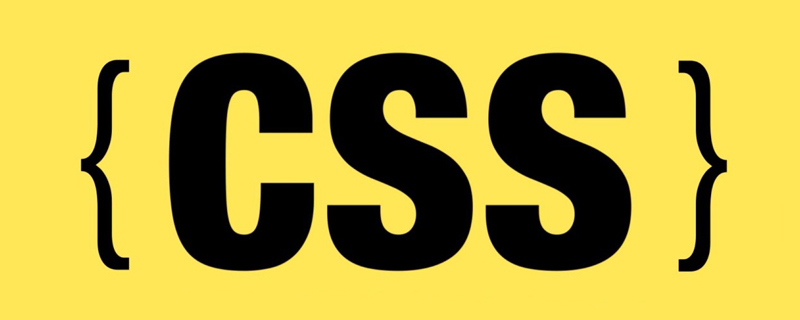This article brings you relevant knowledge about Selenium’s use of CSS positioning summary. CSS positioning also has its value. CSS positioning is faster and the syntax is simpler. I hope it will be helpful to everyone.

When most people use selenium to locate elements, they use xpath positioning. CSS positioning is often ignored. In fact, css positioning also has its value. CSS positioning is more Fast, the syntax is more concise
1. CSS selector
Common symbols:
#represents the id selector
.represents the class selector
>Indicates sub-elements, level
A space also indicates sub-elements, but all descendant sub-elements, which is equivalent to the relative path in xpath
2. CSS: Attribute positioning
css can be directly located through the three regular attributes of the element, id, class, and label.
如下是百度输入框的的html代码: <input>
css uses the # sign to represent the id attribute, such as: #kw
css uses . to represent the class attribute. For example: .s_ipt
css directly uses the tag name without any identifier, such as: input
3. CSS: other attributes
css can use tag, class, and id Conventional attribute positioning can also be used to position other attributes
以下是定位其它属性的格式[name=wd] [autocomplete='off'][maxlength='255']
4. CSS: Tag
css can locate elements through a combination of tags and attributes
input.s_ipt input#kw input[id='kw']
5. CSS: Hierarchical relationship
//form的id属性form#form>span>input //form的class属性form.fm>span>input
6. CSS: Index
css can also locate sub-elements through index
Select控件第三个Opel #select>select>option:nth-child(3)CheckBox第一个Volvo #checkbox>input:nth-child(1)CheckBox第二个Saab #checkbox>input:nth-child(4)RadioBox第二个Saab #radio>input:nth-child(4)
7. CSS: Logical operation
Same as css Logical operations can also be implemented to match two attributes at the same time, which is different from xpath
[type='checkbox'][name='checkbox1']

8. Baidu search box example
Take Baidu’s search box Specifically look at CSS positioning
Positioning input box
Single attribute positioning
type selector
driver.find_element_by_css_selector('input')id 定位
driver.find_element_by_css_selector('#kw')class 定位
driver.find_element_by_css_selector('.s_ipt')其他属性定位
driver.find_element_by_css_selector('[name='wd']')driver.find_element_by_css_selector("[type='text']")
Combined attribute positioning
id组合属性定位
driver.find_element_by_css_selector("input#kw")class组合属性定位
driver.find_element_by_css_selector("input.s_ipt")其他属性组合定位
driver.find_element_by_css_selector("input[name='wd']")仅有属性名,没有值也可以
driver.find_element_by_css_selector("input[name]")两个其他属性组合定位
driver.find_element_by_css_selector("[name='wd'][autocomplete='off']")
9. Click the button on Baidu homepage as an example

Fuzzy matching attribute value method
1>属性值由多个空格隔开,匹配其中一个值的方法
driver.find_element_by_css_selector("input[class~='btn']")2>匹配属性值为字符串开头的方法
driver.find_element_by_css_selector("input[class^='btn']")3>匹配属性值字符串结尾的方法
driver.find_element_by_css_selector("input[class$='s_btn']")
10. The difference between CSS and Xpath positioning
Attribute positioning
CSS
css can pass the element's The three regular attributes of id, class, and label are directly positioned
①. CSS uses the # symbol to represent the id attribute, such as:
id="kw" can be written as: #kw
②. CSS uses . to represent class Attributes, such as:
class="s_ipt" can be written as: .s_ipt
③. css directly uses the label name without any identifier, such as: input
Xpath
xpath can also be passed Locate the elements' id, name, and class attributes
①. Use xpath to locate the id attribute
driver.find_element(By.XPATH,"//[@id='kw']")
②. Use xpath to locate through the name attribute
driver.find_element(By.XPATH,"//[@name='wd']")
③. Use xpath to locate through the class attribute
driver.find_element(By. XPATH,"//*[@class='s_ipt']")
Other attributes
CSS
In addition to the above, css can also be positioned through other attributes
①. css is positioned through the name attribute:
driver.find_element(By.CSS_SELECTOR,"[name='wd']")
②. css is positioned through the autocomplete attribute:
driver.find_element(By. CSS_SELECTOR," [autocomplete='off']")
③.css is positioned through the type attribute:
driver.find_element(By.CSS_SELECTOR,"[type='text']")
Xpath
Without the above attributes, you can locate it through other attributes
driver.find_element(By.XPATH,"//*[@autocomplete='off']")
tag
CSS
The css page can locate elements through the combination of tags and attributes
①. css locates elements through the combination of tags and class attributes driver.find_element(By.CSS_SELECTOR, "input.s_ipt")
②. css through tags Positioning driver.find_element(By.CSS_SELECTOR, "input#kw") in combination with the id attribute
③. css positions driver.find_element(By.CSS_SELECTOR, "input[id='kw'] through the combination of tags and other attributes) ”)
Xpath
1. If there are many attributes with the same name, you can filter them by tags
①. Use xpath to locate driver.find_element(By.XPATH,"// input[@autocomplete='off']")
②. Use xpath to locate driver.find_element(By.XPATH,"//input[@id='kw']")
③. Use xpath locates driver.find_element(By.XPATH,"//name[@id='wd']") through the name attribute
Hierarchical relationship
CSS
Such as: //form [@id='form']/span/input and //form[@class='fm']/span/input
①. css locates driver.find_element(By.CSS_SELECTOR, "form#form> ;span>input”)
②. css locates driver.find_element(By.CSS_SELECTOR, “form.fm>span>input”)
Xpath
1. If an element, Its attributes are not obvious and cannot be located directly. You can first find its parent element, find the parent element, and then find the next level to locate it
①. Locate the input input box by locating the parent element driver.find_element(By. XPATH,"//span[@id='s_kw_wrap']/input")
②. Locate the input input box driver.find_element(By.XPATH,"//form[@id='form ']/span/input")
Index
CSS
1. CSS can also locate child elements through index option: nth-child(1)
①. Select the first child element driver.find_element(By. CSS_SELECTOR,“select#nr>option:nth-child(1)”)
②. Select the second child element driver.find_element(By.CSS_SELECTOR,“select#nr>option:nth-child(2)”)
③. Select the third child element driver.find_element(By.CSS_SELECTOR,“select#nr>option:nth-child(3)”)
Xpath
1. Can be positioned by sorting
①. Use xpath to locate the first driver.find_element(By.XPATH,"//select[@id='nr']/option[1]")
②. Use xpath to locate the second driver. find_element(By.XPATH,"//select[@id='nr']/option[2]")
③. Use xpath to locate the third driver.find_element(By.XPATH,"//select[@ id='nr']/option[3]")
Fuzzy matching
CSS
driver.find_element(By.CSS_SELECTOR,"input:contains('kw')")
Xpath
1. Powerful fuzzy matching of xpath
2. by_partial_link, fuzzy matching positioning
driver.find_element(By.XPATH,"//*[contains(text(),' hao123')]")
11. Summary
Automated testing Two mainstream XPATH and CSS positioning methods for positioning page elements in web testing in Python Selenium
XPATH positioning and CSS positioning Very similar, XPATH is more powerful, but CSS positioning is faster, but some browsers do not support CSS positioning, and it is generally more common to use xpath positioning than css in the automated testing process
( Learning video sharing: css video tutorial)
The above is the detailed content of What you must know about Selenium using CSS positioning summary. For more information, please follow other related articles on the PHP Chinese website!
 css ul标签怎么去掉圆点Apr 25, 2022 pm 05:55 PM
css ul标签怎么去掉圆点Apr 25, 2022 pm 05:55 PM在css中,可用list-style-type属性来去掉ul的圆点标记,语法为“ul{list-style-type:none}”;list-style-type属性可设置列表项标记的类型,当值为“none”可不定义标记,也可去除已有标记。
 css与xml的区别是什么Apr 24, 2022 am 11:21 AM
css与xml的区别是什么Apr 24, 2022 am 11:21 AM区别是:css是层叠样式表单,是将样式信息与网页内容分离的一种标记语言,主要用来设计网页的样式,还可以对网页各元素进行格式化;xml是可扩展标记语言,是一种数据存储语言,用于使用简单的标记描述数据,将文档分成许多部件并对这些部件加以标识。
 css3怎么实现鼠标隐藏效果Apr 27, 2022 pm 05:20 PM
css3怎么实现鼠标隐藏效果Apr 27, 2022 pm 05:20 PM在css中,可以利用cursor属性实现鼠标隐藏效果,该属性用于定义鼠标指针放在一个元素边界范围内时所用的光标形状,当属性值设置为none时,就可以实现鼠标隐藏效果,语法为“元素{cursor:none}”。
 rtl在css是什么意思Apr 24, 2022 am 11:07 AM
rtl在css是什么意思Apr 24, 2022 am 11:07 AM在css中,rtl是“right-to-left”的缩写,是从右往左的意思,指的是内联内容从右往左依次排布,是direction属性的一个属性值;该属性规定了文本的方向和书写方向,语法为“元素{direction:rtl}”。
 css怎么实现英文小写转为大写Apr 25, 2022 pm 06:35 PM
css怎么实现英文小写转为大写Apr 25, 2022 pm 06:35 PM转换方法:1、给英文元素添加“text-transform: uppercase;”样式,可将所有的英文字母都变成大写;2、给英文元素添加“text-transform:capitalize;”样式,可将英文文本中每个单词的首字母变为大写。
 css怎么设置i不是斜体Apr 20, 2022 am 10:36 AM
css怎么设置i不是斜体Apr 20, 2022 am 10:36 AM在css中,可以利用“font-style”属性设置i元素不是斜体样式,该属性用于指定文本的字体样式,当属性值设置为“normal”时,会显示元素的标准字体样式,语法为“i元素{font-style:normal}”。
 怎么设置rotate在css3的旋转中心点Apr 24, 2022 am 10:50 AM
怎么设置rotate在css3的旋转中心点Apr 24, 2022 am 10:50 AM在css3中,可以用“transform-origin”属性设置rotate的旋转中心点,该属性可更改转换元素的位置,第一个参数设置x轴的旋转位置,第二个参数设置y轴旋转位置,语法为“transform-origin:x轴位置 y轴位置”。


Hot AI Tools

Undresser.AI Undress
AI-powered app for creating realistic nude photos

AI Clothes Remover
Online AI tool for removing clothes from photos.

Undress AI Tool
Undress images for free

Clothoff.io
AI clothes remover

AI Hentai Generator
Generate AI Hentai for free.

Hot Article

Hot Tools

SublimeText3 Mac version
God-level code editing software (SublimeText3)

MinGW - Minimalist GNU for Windows
This project is in the process of being migrated to osdn.net/projects/mingw, you can continue to follow us there. MinGW: A native Windows port of the GNU Compiler Collection (GCC), freely distributable import libraries and header files for building native Windows applications; includes extensions to the MSVC runtime to support C99 functionality. All MinGW software can run on 64-bit Windows platforms.

Atom editor mac version download
The most popular open source editor

Dreamweaver CS6
Visual web development tools

VSCode Windows 64-bit Download
A free and powerful IDE editor launched by Microsoft







